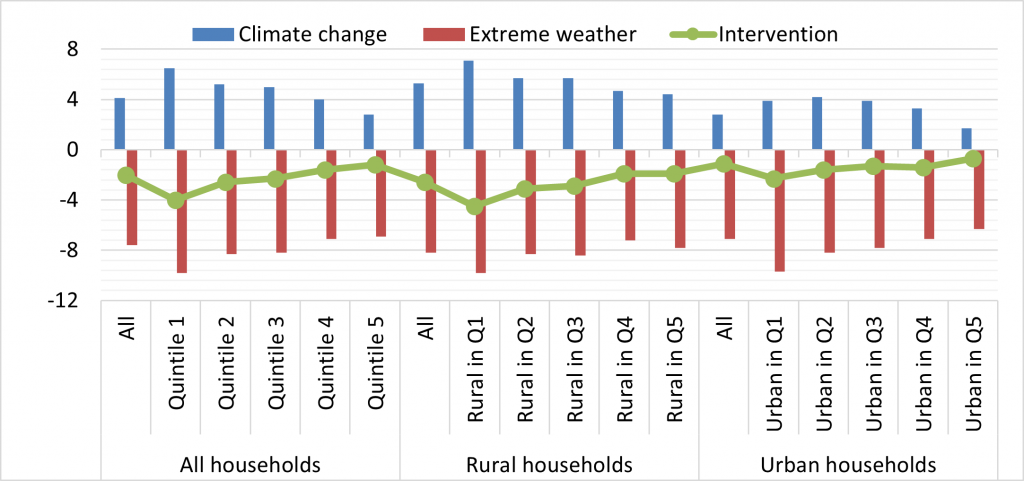by Davit Stepanyan, Khalid Siddig, Manfred Wiebelt, Harald Grethe, and Tingju Zhu
The Sudanese economy heavily depends on agriculture. It accounts for one-third of GDP and half of foreign exchange earnings, and provides a livelihood to 65% of the population as the main employer in the Sudan. Rainfed agriculture occupies 90% of the cultivated land in the country, which is equivalent to 21.2 million ha in 2018. Consequently, agricultural yields are heavily affected by rainfall variability, and thus, are highly volatile (Fig. 1). Besides rainfall variability, yield fluctuations in the Sudan are also caused by recurrent droughts, pest infestation, and low application of fertilizer and other inputs. This raises legitimate concerns regarding the possible consequences of climate change in the Sudan, such as increasing rainfall variability or higher frequency of extreme weather events. To address these concerns and to suggest effective climate change adaptation strategies, a recent study simulates the impacts of climate change as well as the impacts of more frequent extreme weather events on the Sudanese economy through multiple channels until 2050.

Figure 1. Yield of major crops in the Sudan and Africa (ton/hectare, 1998-2017).
Source: FAO (2019)
To quantify the above-mentioned impacts on the Sudanese economy six different climate change scenarios have been analyzed, representing six different future developments caused by six different possible climate change impacts. On top of these climate change scenarios, the study also simulated an extreme weather event scenario, and an intervention scenario supporting the Sudanese economy in adapting to negative climate challenges at the sectoral level. Findings suggest that the climate change scenarios alone have an overall positive impact on the Sudanese economy which, in general, is in line with the findings of other similar studies. However, the picture changes completely when more frequent extreme weather events are taken into account, projecting a cumulative decrease of US$105.5 billion in GDP between 2018 and 2050 compared to a “business as usual” scenario without climate change. Moreover, our results indicate that poor rural households will be affected most as they have a high income share from unskilled and semiskilled labor, which is intensively used in agricultural production (Fig. 2). To mitigate the negative impacts imposed by extreme weather events the following interventions are suggested to enhance agricultural productivity to preserve the level of growth in agricultural GDP similar to that of “business as usual” scenario with no climate change:
- Investing in infrastructure to protect against flooding.
- Investing in extension services with the objectives of reducing and adapting to the negative consequences of climate variability.
- Enhancing land property rights, especially for animal producers, to legally use land like crop producers and demarcating and mapping livestock routes and enforcing their use to increase access to natural productive assets.
- Treating water as a scarce resource and enhancing its efficient use, especially in irrigated agriculture, to best utilize the Sudan's share of Nile water.
Our results show that the implementation of the above-mentioned interventions can reverse the possible losses into gains of US$ 64.1 billion for all households, of which US$ 40.8 billion accrue to rural households, while US$ 23.2 billion are the gains of urban households. These results are based on the assumption that the productivity of rainfed crops will be improved by 2.5% annually until 2050 because of the above-mentioned interventions.

Figure 2. Long-term impact (2018-2050) of the climate scenarios on real household consumption (average annual percentage change from Baseline).
Source: Siddig et al. (2020)
This study leads us to several conclusions. First, many studies concentrate on the average impacts of climate change and adaptation strategies ignoring the risk of more frequent extreme weather events. Such events, however, are already occurring in different parts of the world and may have negative consequences beyond the average temperature and precipitation effects of climate change. Therefore, although some studies analyzing the average climate change impacts on the Sudanese economy anticipate a favorable outcome for the country, they may be misleading. Thus, Sudan should carefully account for the consequences beyond average climate change impacts. Finally, we suggest some interventions to mitigate the negative implication of climate change found by this study by enhancing the productivity of rainfed crops. These interventions include R&D of drought tolerant varieties accompanied by targeted agricultural extension, education, and investments.
Related publications and Links
Siddig, K., D. Stepanyan, M. Wiebelt, H. Grethe and T. Zhu (2020). Climate Change and Agriculture in the Sudan: Impact pathways beyond changes in mean rainfall and temperature. Ecological Economics 169, March 2020. https://doi.org/10.1016/j.ecolecon.2019.106566
Siddig, K., Stepanyan, D., Wiebelt, M., Zhu, T., Grethe, H. (2018). Climate Change and Agriculture in Sudan - Impact Pathways Beyond Changes in Mean Rainfall and Temperature. MENA RP Working Paper 13, International Food Policy Research Institute, Washington, DC, 30 pp. http://ebrary.ifpri.org/cdm/ref/collection/p15738coll2/id/132833
Related projects on Water-Energy-Food Nexus: https://www.ifpri.org/project/water-energy-food-nexus
Davit Stepanyan, Thünen Institute of Farm Economics, Braunschweig, Germany
Khalid Siddig, Humboldt-Universität zu Berlin, Germany and Department of Agricultural Economics, Khartoum University, the Sudan
Manfred Wiebelt, Kiel Institute for the World Economy, Kiel, Germany
Harald Grethe, Humboldt-Universität zu Berlin, Germany
Tingju Zhu, ZJU-UIUC Institute, International Campus, Zhejiang University, China
